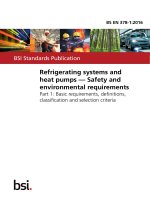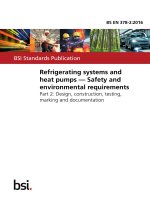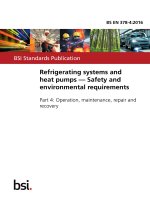Bsi bs en 61968 8 2016
Bạn đang xem bản rút gọn của tài liệu. Xem và tải ngay bản đầy đủ của tài liệu tại đây (2.58 MB, 64 trang )
BS EN 61968-8:2016
BSI Standards Publication
Application integration at
electric utilities — System
interfaces for distribution
management
Part 8: Interfaces for customer operations
BS EN 61968-8:2016 BRITISH STANDARD
National foreword
This British Standard is the UK implementation of EN 61968-8:2016. It is
identical to IEC 61968-8:2015.
The UK participation in its preparation was entrusted to Technical
Committee PEL/57, Power systems management and associated
information exchange.
A list of organizations represented on this committee can be obtained on
request to its secretary.
This publication does not purport to include all the necessary provisions of
a contract. Users are responsible for its correct application.
© The British Standards Institution 2016.
Published by BSI Standards Limited 2016
ISBN 978 0 580 64105 3
ICS 33.200
Compliance with a British Standard cannot confer immunity from
legal obligations.
This British Standard was published under the authority of the
Standards Policy and Strategy Committee on 31 May 2016.
Amendments/corrigenda issued since publication
Date Text affected
EUROPEAN STANDARD BS EN 61968-8:2016
NORME EUROPÉENNE
EUROPÄISCHE NORM EN 61968-8
ICS 33.200 May 2016
English Version
Application integration at electric utilities - System interfaces for
distribution management - Part 8: Interfaces for customer
operations
(IEC 61968-8:2015)
Application integration at electric utilities - System interfaces Integration von Anwendungen in Anlagen der
for distribution management - Part 8 : interface standard for Elektrizitätsversorgung - Systemschnittstellen für
Netzführung - Teil 8: Schnittstellen Normen für den
customer support
(IEC 61968-8:2015) Kundendienst
(IEC 61968-8:2015)
This European Standard was approved by CENELEC on 2015-07-01. CENELEC members are bound to comply with the CEN/CENELEC
Internal Regulations which stipulate the conditions for giving this European Standard the status of a national standard without any alteration.
Up-to-date lists and bibliographical references concerning such national standards may be obtained on application to the CEN-CENELEC
Management Centre or to any CENELEC member.
This European Standard exists in three official versions (English, French, German). A version in any other language made by translation
under the responsibility of a CENELEC member into its own language and notified to the CEN-CENELEC Management Centre has the
same status as the official versions.
CENELEC members are the national electrotechnical committees of Austria, Belgium, Bulgaria, Croatia, Cyprus, the Czech Republic,
Denmark, Estonia, Finland, Former Yugoslav Republic of Macedonia, France, Germany, Greece, Hungary, Iceland, Ireland, Italy, Latvia,
Lithuania, Luxembourg, Malta, the Netherlands, Norway, Poland, Portugal, Romania, Slovakia, Slovenia, Spain, Sweden, Switzerland,
Turkey and the United Kingdom.
European Committee for Electrotechnical Standardization
Comité Européen de Normalisation Electrotechnique
Europäisches Komitee für Elektrotechnische Normung
CEN-CENELEC Management Centre: Avenue Marnix 17, B-1000 Brussels
© 2016 CENELEC All rights of exploitation in any form and by any means reserved worldwide for CENELEC Members.
Ref. No. EN 61968-8:2016 E
BS EN 61968-8:2016
EN 61968-8:2016
European foreword
The text of document 57/1548/FDIS, future edition 1 of IEC 61968-8, prepared by IEC/TC 57, "Power
systems management and associated information exchange" was submitted to the IEC-CENELEC
parallel vote and approved by CENELEC as EN 61968-8:2016.
The following dates are fixed:
• latest date by which the document has (dop) 2016-11-13
to be implemented at national level by (dow) 2019-05-13
publication of an identical national
standard or by endorsement
• latest date by which the national
standards conflicting with the
document have to be withdrawn
Attention is drawn to the possibility that some of the elements of this document may be the subject of
patent rights. CENELEC [and/or CEN] shall not be held responsible for identifying any or all such
patent rights.
Endorsement notice
The text of the International Standard IEC 61968-8:2015 was approved by CENELEC as a European
Standard without any modification.
2
BS EN 61968-8:2016
EN 61968-8:2016
Annex ZA
(normative)
Normative references to international publications
with their corresponding European publications
The following documents, in whole or in part, are normatively referenced in this document and are
indispensable for its application. For dated references, only the edition cited applies. For undated
references, the latest edition of the referenced document (including any amendments) applies.
NOTE 1 When an International Publication has been modified by common modifications, indicated by (mod), the relevant
EN/HD applies.
NOTE 2 Up-to-date information on the latest versions of the European Standards listed in this annex is available here:
www.cenelec.eu.
Publication Year Title EN/HD Year
IEC 60050 - International Electrotechnical Vocabulary - -
IEC 61968-1 - (IEV) EN 61968-1 -
Application integration at electric utilities -
IEC 61968-6 - System interfaces for distribution - -
management -- Part 1: Interface
IEC 61968-11 - architecture and general requirements EN 61968-11 -
Application integration at electric utilities -
IEC 61968-100 - System interfaces for distribution EN 61968-100 -
management - Part 6: Interfaces for
IEC 61970-301 - maintenance and construction EN 61970-301 -
IEC/TS 61968-2 - Application integration at electric utilities - - -
System interfaces for distribution
management -- Part 11: Common
information model (CIM) extensions for
distribution
Application integration at electric utilities -
System interfaces for distribution
management -- Part 100: Implementation
profiles
Application integration at electric utilities -
System interfaces for distribution
management -- Part 2: Glossary
3
– 2 – BS EN 61968-8:2016
IEC 61968-8:2015 IEC 2015
CONTENTS
FOREW ORD ........................................................................................................................... 4
1 Scope ..............................................................................................................................7
2 Normative references ......................................................................................................7
3 Terms, definitions and abbreviations ...............................................................................7
3.1 Terms and definitions..............................................................................................7
3.2 Abbreviations ..........................................................................................................8
4 Reference and information models ..................................................................................8
4.1 Reference model.....................................................................................................8
4.1.1 General ...........................................................................................................8
4.1.2 Customer support (CS) ....................................................................................9
4.2 Customer support functions and components ..........................................................9
4.3 Static information model .........................................................................................9
4.3.1 General ...........................................................................................................9
4.3.2 Classes for customer support ..........................................................................9
5 Customer support message types .................................................................................. 10
5.1 General................................................................................................................. 10
5.2 Trouble ticket ........................................................................................................ 11
5.2.1 General ......................................................................................................... 11
5.2.2 Message format ............................................................................................. 12
5.3 Incident information .............................................................................................. 12
5.3.1 General ......................................................................................................... 12
5.3.2 Message format ............................................................................................. 14
5.4 Service request..................................................................................................... 15
5.4.1 General ......................................................................................................... 15
5.4.2 Message format ............................................................................................. 16
5.5 Service order ........................................................................................................ 17
5.5.1 General ......................................................................................................... 17
5.6 Work request ........................................................................................................ 17
5.6.1 General ......................................................................................................... 17
5.7 Customer agreement ............................................................................................ 18
5.7.1 General ......................................................................................................... 18
5.7.2 Message format ............................................................................................. 20
Annex A (normative) XML schemas for message payloads .................................................. 21
Bibliography.......................................................................................................................... 58
Figure 1 – IEC 61968-8 context model ....................................................................................8
Figure 2 – Example of trouble ticket exchange between CIS and OMS..................................11
Figure 3 – Trouble ticket message ........................................................................................ 12
Figure 4 – Example of incident information exchange between OMS and CIS .......................13
Figure 5 – Incident information message...............................................................................14
Figure 6 – Example of a service request exchange between CIS and WMS ..........................15
Figure 7 – Service request message ..................................................................................... 16
Figure 8 – Example of a service order exchange between CIS and WMS ..............................17
Figure 9 – Example of a work request exchange between CIS and WMS ..............................18
BS EN 61968-8:2016 – 3 –
IEC 61968-8:2015 IEC 2015
Figure 10 – Example of a customer exchange between CIS and external or third party
systems ................................................................................................................................ 19
Figure 11 – Customer agreement message ...........................................................................20
Figure A.1 – Trouble ticket XSD ............................................................................................ 24
Figure A.2 – Incident information XSD ..................................................................................28
Figure A.3 – Customer agreement XSD ................................................................................35
Figure A.4 – Service request XSD.........................................................................................57
Table 1 – Document overview for IEC 61968-8 .......................................................................6
Table 2 – Business functions and abstract components ..........................................................9
Table 3 – Customer support classes .....................................................................................10
– 4 – BS EN 61968-8:2016
IEC 61968-8:2015 IEC 2015
INTERNATIONAL ELECTROTECHNICAL COMMISSION
___________
APPLICATION INTEGRATION AT ELECTRIC UTILITIES –
SYSTEM INTERFACES FOR DISTRIBUTION MANAGEMENT –
Part 8: Interfaces for customer operations
FOREWORD
1) The International Electrotechnical Commission (IEC) is a worldwide organization for standardization comprising
all national electrotechnical committees (IEC National Committees). The object of IEC is to promote
international co-operation on all questions concerning standardization in the electrical and electronic fields. To
this end and in addition to other activities, IEC publishes International Standards, Technical Specifications,
Technical Reports, Publicly Available Specifications (PAS) and Guides (hereafter referred to as “IEC
Publication(s)”). Their preparation is entrusted to technical committees; any IEC National Committee interested
in the subject dealt with may participate in this preparatory work. International, governmental and non-
governmental organizations liaising with the IEC also participate in this preparation. IEC collaborates closely
with the International Organization for Standardization (ISO) in accordance with conditions determined by
agreement between the two organizations.
2) The formal decisions or agreements of IEC on technical matters express, as nearly as possible, an international
consensus of opinion on the relevant subjects since each technical committee has representation from all
interested IEC National Committees.
3) IEC Publications have the form of recommendations for international use and are accepted by IEC National
Committees in that sense. While all reasonable efforts are made to ensure that the technical content of IEC
Publications is accurate, IEC cannot be held responsible for the way in which they are used or for any
misinterpretation by any end user.
4) In order to promote international uniformity, IEC National Committees undertake to apply IEC Publications
transparently to the maximum extent possible in their national and regional publications. Any divergence
between any IEC Publication and the corresponding national or regional publication shall be clearly indicated in
the latter.
5) IEC itself does not provide any attestation of conformity. Independent certification bodies provide conformity
assessment services and, in some areas, access to IEC marks of conformity. IEC is not responsible for any
services carried out by independent certification bodies.
6) All users should ensure that they have the latest edition of this publication.
7) No liability shall attach to IEC or its directors, employees, servants or agents including individual experts and
members of its technical committees and IEC National Committees for any personal injury, property damage or
other damage of any nature whatsoever, whether direct or indirect, or for costs (including legal fees) and
expenses arising out of the publication, use of, or reliance upon, this IEC Publication or any other IEC
Publications.
8) Attention is drawn to the Normative references cited in this publication. Use of the referenced publications is
indispensable for the correct application of this publication.
9) Attention is drawn to the possibility that some of the elements of this IEC Publication may be the subject of
patent rights. IEC shall not be held responsible for identifying any or all such patent rights.
International Standard IEC 61968-8 has been prepared by IEC technical committee 57: Power
systems management and associated information exchange.
The text of this standard is based on the following documents:
FDIS Report on voting
57/1548/FDIS 57/1573/RVD
Full information on the voting for the approval of this standard can be found in the report on
voting indicated in the above table.
This publication has been drafted in accordance with the ISO/IEC Directives, Part 2.
A list of all parts of the IEC 61968 series, under the general title: Application integration at
electric utilities – System interfaces for distribution management, can be found on the IEC
website.
BS EN 61968-8:2016 – 5 –
IEC 61968-8:2015 IEC 2015
The committee has decided that the contents of this publication will remain unchanged until
the stability date indicated on the IEC web site under "" in the data
related to the specific publication. At this date, the publication will be
• reconfirmed,
• withdrawn,
• replaced by a revised edition, or
• amended.
A bilingual version of this publication may be issued at a later date.
IMPORTANT – The 'colour inside' logo on the cover page of this publication indicates
that it contains colours which are considered to be useful for the correct
understanding of its contents. Users should therefore print this document using a
colour printer.
– 6 – BS EN 61968-8:2016
IEC 61968-8:2015 IEC 2015
INTRODUCTION
The purpose of this part of IEC 61968 is to define a standard for the integration of Customer
Support (CS), which would include Customer Service, Trouble Management and Point of Sale
related components integrated with other systems and business functions within the scope of
IEC 61968. The scope of this standard is the exchange of information between a customer
support system and other systems within the utility enterprise.
The IEC 61968 series of standards is intended to facilitate inter-application integration as
opposed to intra-application integration. Intra-application integration is aimed at programs in
the same application system, usually communicating with each other using middleware that is
embedded in their underlying runtime environment, and tends to be optimised for close, real-
time, synchronous connections and interactive request/reply or conversation communication
models. IEC 61968, by contrast, is intended to support the inter-application integration of a
utility enterprise that needs to connect disparate applications that are already built or new
(legacy or purchased applications), each supported by dissimilar runtime environments.
Therefore, these interface standards are relevant to loosely coupled applications with more
heterogeneity in languages, operating systems, protocols and management tools. This series
of standards is intended to support applications that need to exchange data every few
seconds, minutes, or hours rather than waiting for a nightly batch run. This series of
standards, which are intended to be implemented with middleware services that exchange
messages among applications, will complement, not replace utility data warehouses,
database gateways, and operational stores.
As used in IEC 61968, a Distribution Management System (DMS) consists of various
distributed application components for the utility to manage electrical distribution networks.
These capabilities include monitoring and control of equipment for power delivery,
management processes to ensure system reliability, voltage management, demand-side
management, outage management, work management, automated mapping and facilities
management. Standard interfaces are defined for each class of applications identified in the
Interface Reference Model (IRM), which is described in IEC 61968-1: Application integration
at electric utilities – System interfaces for distribution management – Interface Architecture
and General Requirements.
This part of IEC 61968 contains the clauses listed in Table 1.
Table 1 – Document overview for IEC 61968-8
Clause Title Purpose
1. Scope The scope and purpose of the document are described.
2. Normative references Documents that contain provisions which, through reference in
3. this text, constitute provisions of this international standard.
4. Terms, definitions and
abbreviations Description of general approach to customer support,
5. Reference and information reference model, interface reference model, customer support
Annex A models functions and components, message type terms and static
information model.
Customer support message Message types related to the exchange of information for
types documents related to customer services.
Sample XML schemas for To provide XSD information for information use only.
message payloads
BS EN 61968-8:2016 – 7 –
IEC 61968-8:2015 IEC 2015
APPLICATION INTEGRATION AT ELECTRIC UTILITIES –
SYSTEM INTERFACES FOR DISTRIBUTION MANAGEMENT –
Part 8: Interfaces for customer operations
1 Scope
This part of IEC 61968 specifies the information content of a set of message types that can be
used to support many of the business functions related to customer support. Typical uses of
the message types include service request, customer agreement, and trouble management.
The purpose of this part of IEC 61968 is to define a standard for the integration of customer
support (CS), which would include customer service, trouble management and point of sale
related components integrated with other systems and business functions within the scope of
IEC 61968. The scope of this standard is the exchange of information between a customer
support system and other systems within the utility enterprise.
2 Normative references
The following documents, in whole or in part, are normatively referenced in this document and
are indispensable for its application. For dated references, only the edition cited applies. For
undated references, the latest edition of the referenced document (including any
amendments) applies.
IEC 60050, International Electrotechnical Vocabulary
IEC 61968-1, Application integration at electric utilities – System interfaces for distribution
management – Part 1: Interface architecture and general recommendations
IEC TS 61968-2, Application integration at electric utilities – System interfaces for distribution
management – Part 2: Glossary
IEC 61968-6, Application integration at electric utilities – System interfaces for distribution
management – Part 6: Interfaces for maintenance and construction1
IEC 61968-11, Application integration at electric utilities – System interfaces for distribution
management – Part 11: Common information model (CIM) extensions for distribution
IEC 61968-100, Application integration at electric utilities – System interfaces for distribution
management – Part 100: Implementation profiles
IEC 61970-301, Energy management system application program interface (EMS-API) – Part
301: Common information model (CIM) base
3 Terms, definitions and abbreviations
3.1 Terms and definitions
For the purposes of this standard, the terms and definitions given in IEC 60050-300,
IEC 61968-2, IEC 62051 and IEC 62055-31 apply.
Where there is a difference between the definitions in this standard and those contained in
other referenced IEC standards, then those defined in IEC 61968-2 shall take precedence
over the others listed, and those defined in this document shall take precedence over those
defined in IEC 61968-2.
______________
1 To be published.
– 8 – BS EN 61968-8:2016
IEC 61968-8:2015 IEC 2015
3.2 Abbreviations
CIM Common information model
CIS Customer information system
CRM Customer relationship management
CSR Customer service representative
ERT Estimated restoration time
IVR Interactive voice response
NO Network operations
OMS Outage management system
POS Point of sale
UML Unified modelling language
WMWork management
XSD XML schema definition
4 Reference and information models
4.1 Reference model
4.1.1 General
The diagram in Figure 1 serves as a reference model and provides examples of the logical
components and data flows related to the context of this part of IEC 61968.
Figure 1 describes the information flows between the components defined in this part of
IEC 61968 and the components in the reference model defined in IEC 61968-1.
(10) External 61968 Parts 3-10 (3) Trouble call
to DMS (EXT-ACT) management (NO)
(6) Maintenance and
construction (MC)
(5) (3) (4) (2) (1)
(6)
Customer service Trouble call
(CSRV) management (TCM)
Part 8 Customer support (CS)
1. Trouble ticket IEC
2. Incident information
3. Service order
4. Work request
5. Customer agreement
6. Service request
Figure 1 – IEC 61968-8 context model
BS EN 61968-8:2016 – 9 –
IEC 61968-8:2015 IEC 2015
4.1.2 Customer support (CS)
Typical tasks of customer support:
• Customer services may include, but are not limited to, customer enquiries, new service,
program enrollment and service or work request updates.
• Trouble call management may include, but are not limited to, trouble calls reported from
customers and non-customers, outage notifications and restoration updates.
4.2 Customer support functions and components
Table 2 shows these functions and typical abstract components that are expected to be
producers of information for these message types. Typical consumers of the information
include, but are not restricted to, the other components as listed in IEC 61968-1.
Table 2 – Business functions and abstract components
Customer support (CS) Service requests
Construction billing inquiry
Customer service (CSRV) Billing inquiry
Trouble call management (TCM) Work status
Self-service inquiry
Customer connection
Turn on, turn off
Line losses
Service level agreements
Customer information analysis
Customer information management
Customer relationship management
Outage calls
Power quality
Planned outage notifications
Media communication
Performance indices
Restoration projection/confirmation
Outage history
Point of sale (POS)
4.3 Static information model
4.3.1 General
The information model relevant to customer support consists of classes that provide a
template for the attributes for each message.
The classes are defined in detail in IEC 61968-11, Application integration at electric utilities –
System interfaces for distribution management – Part 11: Common Information Model (CIM)
Extensions for Distribution or in IEC 61970-301, Energy management system application
program interfaces (EMS-API) – Part 301: Common information model (CIM) base.
4.3.2 Classes for customer support
Table 3 lists classes used within message types. Usually all the attributes of these classes
are contained within a message type. The descriptions provided describe usage within this
part.
Classes described as type "Customer" are defined in the 61968/customer package of the CIM.
– 10 – BS EN 61968-8:2016
IEC 61968-8:2015 IEC 2015
Table 3 – Customer support classes
Class/Noun Package Description
Customer Customers
CustomerAgreement Customers Organisation receiving services from service supplier
DemandResponseProgram Metering Agreement between the customer and the service supplier to pay
Incident Operations for service at a specific service location. It records certain billing
information about the type of service provided at the service
Location Common location and is used during charge creation to determine the type
of service
Outage Operations
Demand response program
ServiceCategory Customers
ServiceLocation Customers Description of a problem in the field that may be reported in a
TroubleTicket Customers trouble ticket or come from another source. It may have to do
with an outage
Work Work
The place, scene, or point of something where someone or
something has been, is, and/or will be at a given moment in time.
It can be defined with one or more position points (coordinates)
in a given coordinate system
Document describing details of an active or planned outage in a
part of the electrical network.
A non-planned outage may be created upon:
– a breaker trip,
– a fault indicator status change,
– a meter event indicating customer outage,
– a reception of one or more customer trouble calls, or
– an operator command, reflecting information obtained from
the field crew.
Outage restoration may be performed using a switching plan
which complements the outage information with detailed
switching activities, including the relationship to the crew and
work.
A planned outage may be created upon:
– a request for service, maintenance or construction work in
the field, or
– an operator-defined outage for what-if/contingency network
analysis.
The associated outage plan defines operational restrictions and
atomic switch actions to define the changes that, after applied,
would result in a total or partial equipment outage as required for
network analysis.
Category of service provided to the customer
A real estate location, commonly referred to as premise
A document that provides details about trouble in the power
network
Document used to request, initiate, track and record work
NOTE The class definitions provided here are for convenience purposes only. The normative definitions are
provided by IEC 61968-11, which describes the distribution extensions to the IEC CIM standard.
5 Customer support message types
5.1 General
The purpose of this section is to describe the message types related to IEC 61968-8. It is
important to note that some of these message types may also be used by other parts of
IEC 61968. The general approach to the realization of message structures and XML schemas
for IEC 61968 messages is described in IEC 61968-1 and IEC 61968-100.
It is also important to note that the use cases and sequence diagrams provided in this
standard are informative in nature, and are intended to provide examples of usage for the
BS EN 61968-8:2016 – 11 –
IEC 61968-8:2015 IEC 2015
normative messages definitions. There is no intent by this standard to standardize specific
business processes.
5.2 Trouble ticket
5.2.1 General
Many electric utilities depend on the calls from the customers to begin the process to identify
the location of the faulted section of the electric distribution circuit. The trouble ticket is the
communication mechanism between the utility and the customer that is used to initiate an
analysis to determine where best to deploy field personnel for service restoration. The trouble
ticket is typically created based on direct conversation with the customer. The trouble ticket is
also created based on customer report via an automated call taking system and on an outage
report from an AMI meter. The trouble ticket contains the information of a customer call.
Once created, the trouble ticket may be sent to the OMS for further processing.
Figure 2 provides a sequence diagram showing the use case for communication between the
CIS and OMS using the trouble ticket message. Figure 3 presents an XSD diagram showing
the contents of the trouble ticket message.
sd Trouble ticket
CS-TCM NO-FLT
(CIS) (OMS)
Call taker obtains all the relevent
information from the customer and enters
the data into the call tracking application
Created (trouble ticket)
Obtain connectivity topology
and determine potential
scope of trouble
opt
Changed (trouble ticket)
IEC
Figure 2 – Example of trouble ticket exchange between CIS and OMS
– 12 – BS EN 61968-8:2016
IEC 61968-8:2015 IEC 2015
5.2.2 Message format
IEC
Figure 3 – Trouble ticket message
5.3 Incident information
5.3.1 General
When there is an outage and it is a confirmed outage, utilities typically can provide an
estimated restoration time (ERT) depending on where the event is within the outage
management processes. A request is made to outage management for a status update on a
particular trouble ticket assigned to an outage incident, or to determine if an incident already
exists before creating a trouble ticket (See Figure 4 showing the use case for this message
exchange).
BS EN 61968-8:2016 – 13 –
IEC 61968-8:2015 IEC 2015
When making a trouble call, some callers request for a call back at a certain point in the
restoration phase; e.g. at the time of arrival of the crew or when the supply is restored. This
message needs to be created when the call back is due and lists the customers requiring call
back. While the incident information message is generated by the Outage Management
System (OMS), it is included in this document to complete the interaction between the CIS
and the OMS and will be removed from this standard when the message is included in the
IEC 61968-3. Figure 5 details the contents of the incident information message and includes
the required elements of the CIS as well as the OMS.
sd Incident information
NO-FLT CS-CSRV
(OMS)
Changed (incident information)
Update associated
trouble ticket
IEC
Figure 4 – Example of incident information exchange between OMS and CIS
– 14 – BS EN 61968-8:2016
IEC 61968-8:2015 IEC 2015
5.3.2 Message format
IEC
Figure 5 – Incident information message
BS EN 61968-8:2016 – 15 –
IEC 61968-8:2015 IEC 2015
5.4 Service request Service
5.4.1 General
Customers initiate service requests as their main point of contact with the utility.
requests by a customer may include but are not limited to:
• Request to turn an existing service on or off (move in/move out, seasonal, etc.)
• Request a new service (electrification of a garage, new house, etc.)
• Request investigation into power quality or other concern about an existing service
(not a trouble or outage call)
• Enroll or de-enroll in a customer program (demand response, etc.)
• Account issues (billing inquiries, high bill complaints, etc.)
Service requests may be initiated:
• In person at a utility office with a customer service representative (CSR)
• Over the internet to CIS or CRM systems
• Through an automated IVR system
• Over the telephone with a CSR
Once a service request is received, the CIS sends it to the WMS for further processing
(see Figure 6).
Service requests may:
• Be manually handled by a customer service representative
• Cause a service order to be created and assigned to a field service technician/crew
• Cause a work request to be created in work management, which in turn may generate
a work order or some other action
Service requests are typically handled by a manual process, but increasingly require an
electronic representation between front end systems such as IVR and CRM, which send a
service request message (see Figure 7 for message contents) to the customer information
system.
sd Service order
Customer MC-SCHD
support
Customer or person creates
a service request
Created (service request)
IEC
Figure 6 – Example of a service request exchange between CIS and WMS
– 16 – BS EN 61968-8:2016
IEC 61968-8:2015 IEC 2015
5.4.2 Message format
IEC
Figure 7 – Service request message









